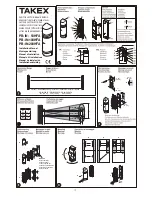
PCMCIA 1 Port RS422/485
Additional 422/485 Operation
Chapter 4 Page 42
a third party communications program that prevents the use of the
RTS signal as a "transmit enable" control, via the TXD GATE
jumper. It can be used in the following situations:-
a)
The PC is connected to only ONE RS485 device.
b)
The PC is communicating with several RS485 devices that
are each able to recognize and respond to their own unique address.
The RS485 devices only drive their TXD lines when they are
responding to requests from the PC to send data. In effect, the RS485
device’s address and the command it receives is used to control
access to the devices TXD channel.
This is a Full Duplex system. Two twisted pair cables are
required. One twisted pair, is the PC’s TXD channel, it carries the
data sent from the PC’s TXD outputs to the RXD inputs of each of
the RS485 devices. The second twisted pair, is the Devices TXD
channel, it carries the data sent from each of the devices’ TXD
outputs to the RXD inputs of the PC.
The advantages of this system are great, since no new
communications, software is needed, and the PC can talk and listen
at the same time. In effect, the handshaking is performed by the
intelligence of the RS485 devices attached to the PC.
When wired as in Figure 4-6 below, the PC can transmit data
at any time and all the RS485 devices #1 to #n simultaneously
receives it.
Only one of the RS485 devices may talk, i.e. transmit data, at
any one time. Each RS485 device recognizes commands and data
addressed to it, it only talks when the PC commands it to do so.
When the RS485 device receives the command to talk from the PC,
it gates its TXD drivers on, sends the data down the device TXD
channel, and disables its TXD drivers. The other RS485 devices
remain in the receive only mode when they are not being addressed,
they do not transmit any data at all.
Artisan Technology Group - Quality Instrumentation ... Guaranteed | (888) 88-SOURCE | www.artisantg.com






































